Surrounded, and protected, by the Arabian Sea, Murud-Janjira fort is an impenetrable bastion that was self-sustaining and never defeated. Even as a tourist destination, getting there is trickier than it looks.
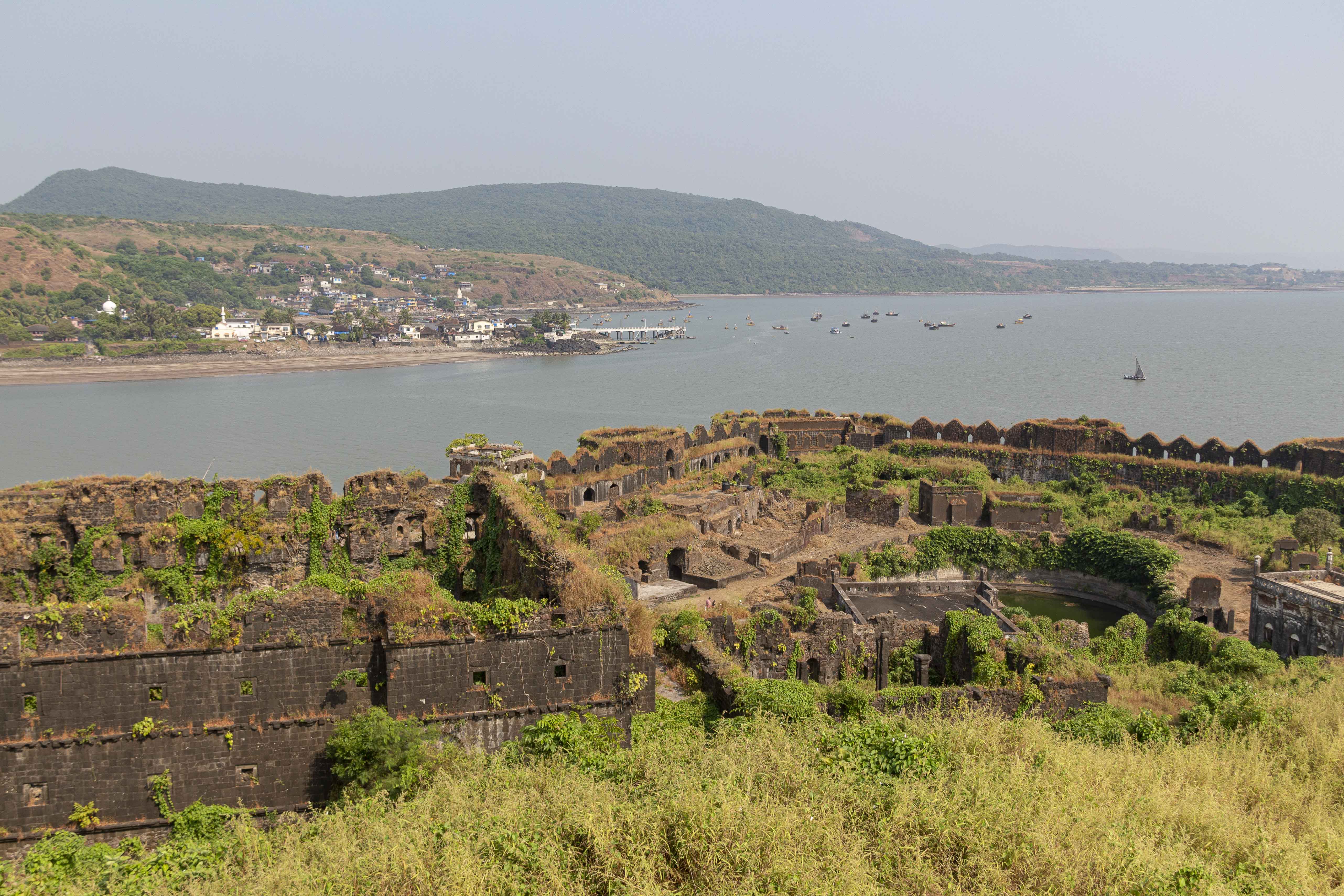
View of the fort and mainland from the lookout point (Photo: Paul Stafford for TravelMag)
Murud-Janjira fort transformed the island. From the shoreline, I didn’t see the expected rocky protrusion lapped by the waves of the Arabian Sea. Instead of jagged rocks, I saw the elegant, thick curves of a fort’s bulwarks rising vertically from the water. Atop the crenellations were shrubs that had worked their way into the cracks between each block of ashy stone. Cannon, rouged by rust, poked through various embrasures. Just above the wall, the small island’s highest point peaked into a rocky viewpoint with excellent command over the whole shoreline and sea.
Sidestepping a goat that was gnawing at the dry grass verge, I climbed back into the rickshaw where my partner, Helena, and driver, Ajay, waited in the shade. We were travelling the short distance to Rajapuri port from Murud town, where the detritus of Dussehra, which had been celebrated the preceding week, littered the grubby streets and beaches. Chains of marigolds were being eaten by caramel coloured cows or pecked at by egrets.
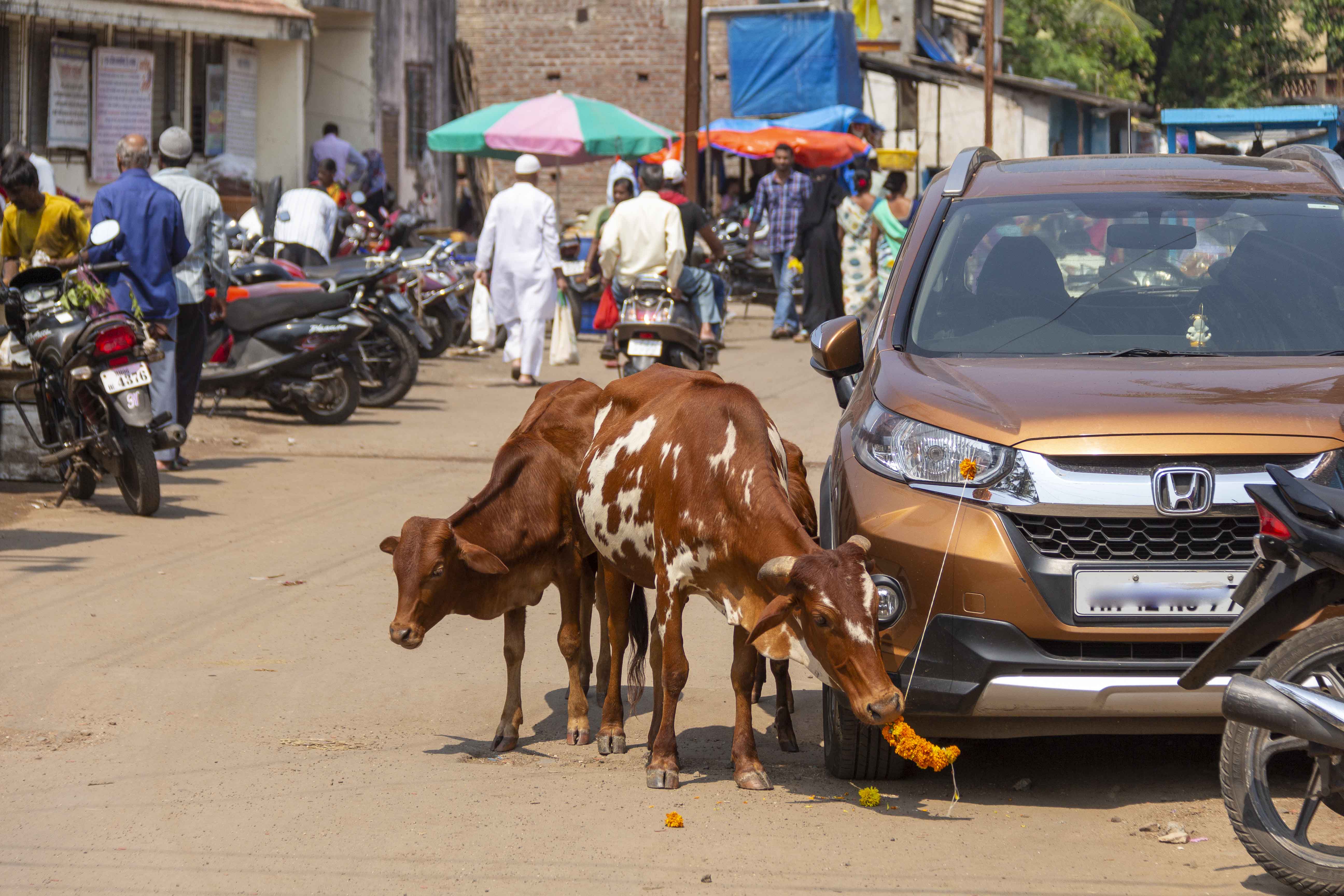
Cows eat marigolds from a car (Photo: Paul Stafford for TravelMag)
The rickshaw had seen better days and struggled with even the slightest of inclines. Every time we offered to get out and walk the hill though, Ajay waved our concerns away, and so we put-putted up the hair-pinning road at a couple of miles an hour, straining the motor to the fringes of its ability.
Murud lies some 62 miles (100km) south of Mumbai. Now part of Maharashtra state in India, this stretch of coastline was formerly a princely vassal known as Janjira State under the British Raj. Although only a small, hilly sliver of coastline, the region is notable because the Janjira settlers were of African origin. More specifically, the Ethiopian Siddi, who colonised the area having traversed the Arabian Sea and captured the island where the fort now stands.
The Siddi were mostly fisherfolk, and that way of life still proliferates. Nets were spread out to dry in the afternoon sun, after the morning’s catch had been hauled in on the dozens of colourful wooden vessels. Each boat was adorned with orange and yellow flags, with bows that scimitared higher out of the water than their sterns. In the afternoons elderly women with sun darkened skin spread out bucket-loads of tiny shrimp with a handheld brush on the hot tarmac road to dry out, without much concern about the gravel or dried cow pats that also covered it.
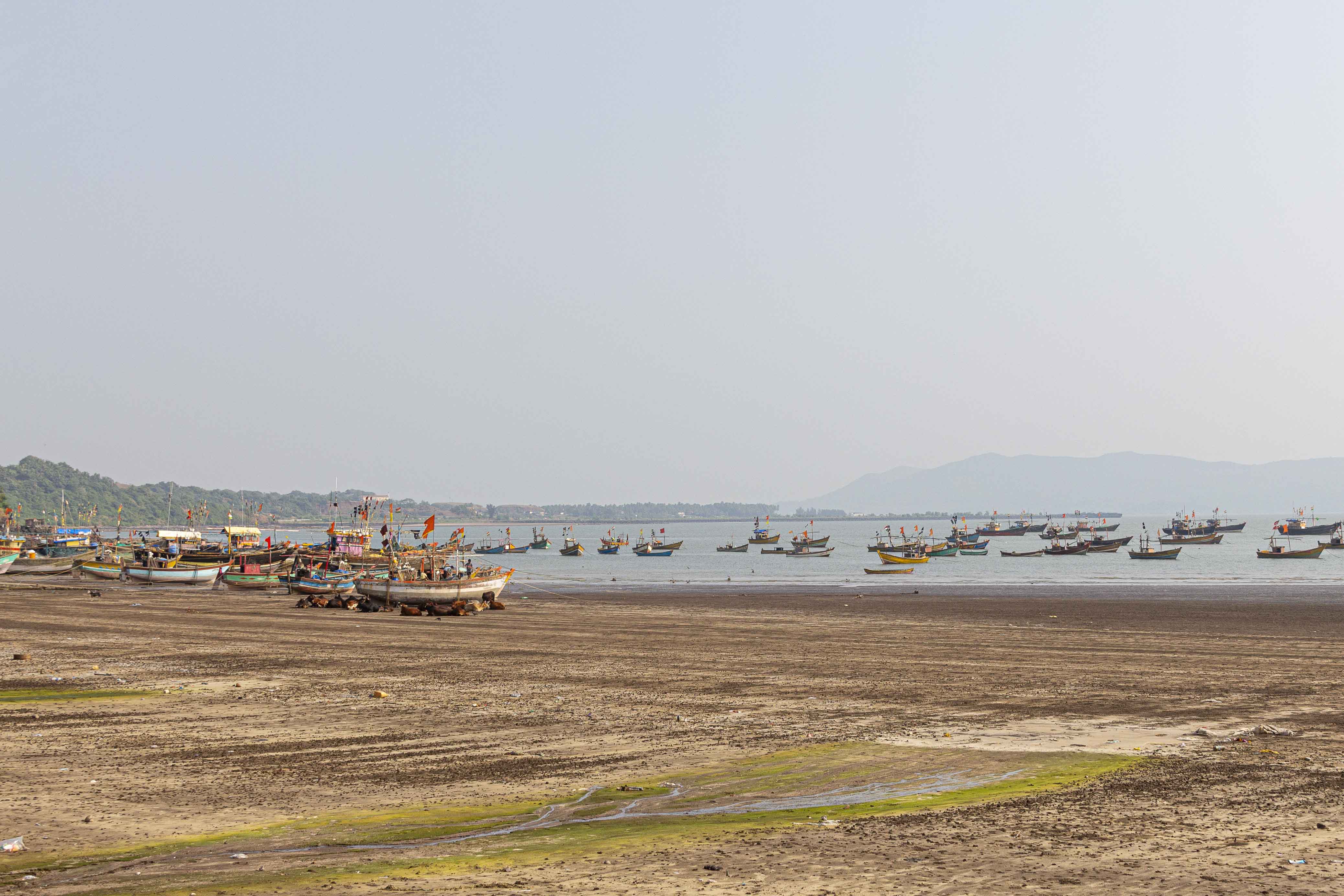
Fishing boats line the sand at Murud (Photo: Paul Stafford for TravelMag)
Rajapuri pier was serene but exposed to the full onslaught of the midday sun. Heading towards us was a pretty wooden sailboat, overladen with people. From the land, we watched these boats, shaped like apple seeds, coming and going from a concealed opening in the fort walls. From a distance there was something quite romantic about the lack of engines. The sailboats somehow hoisted the fort into the present, so that everything felt simultaneously historic and contemporary.
As it drew alongside the pier, a sailboat named Rabbani, was divested of its passengers. No fewer than 40 people had been sardined on the bare wood planks, despite the boat being little more than seven metres long and three metres wide.
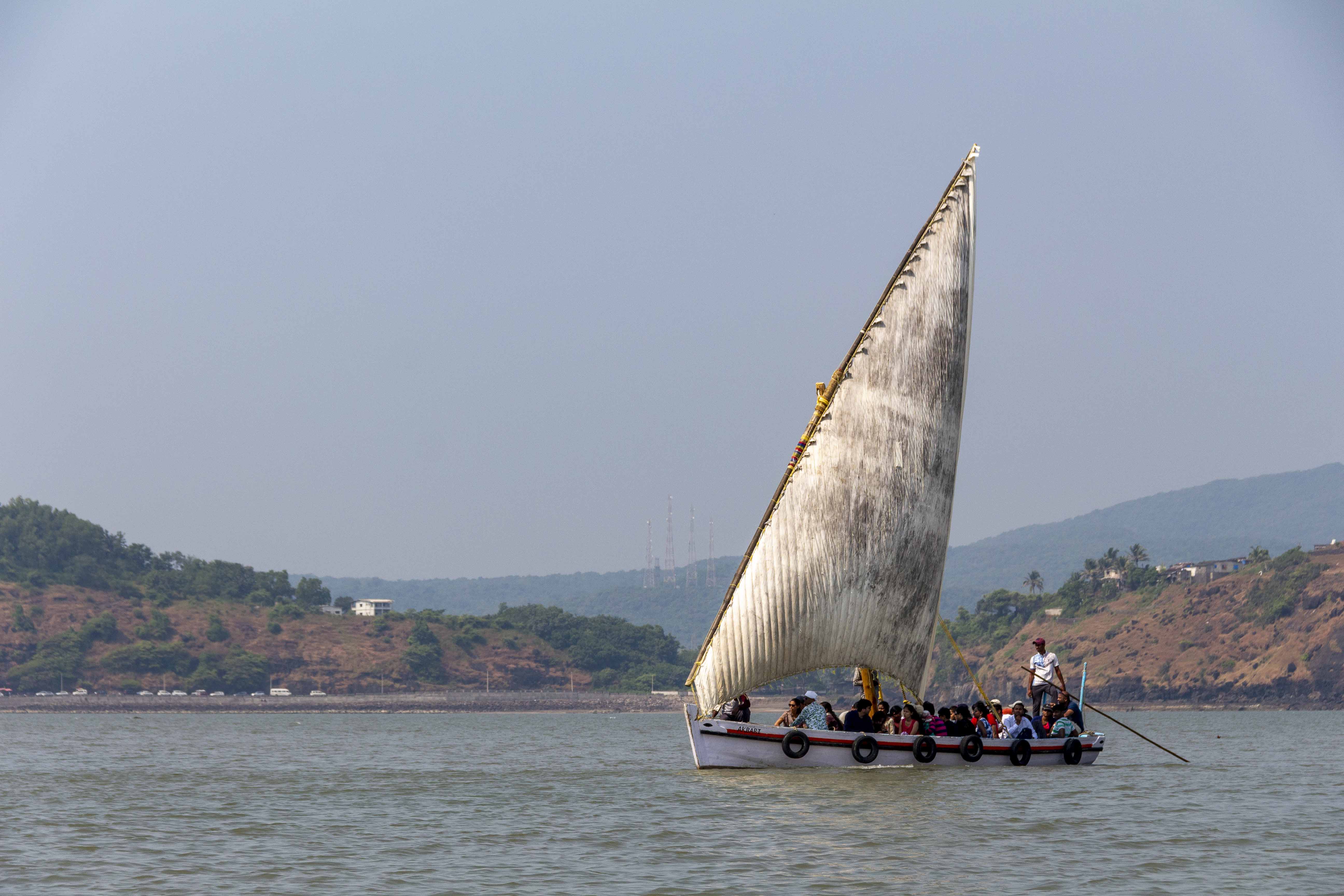
A sailboat heading to Murud-Janjira fort (Photo: Paul Stafford for TravelMag)
Helena and I were the first to board and hunched our knees up to our chests to allow space for others. Some people were ranged around the very edges of the boat, while some stood in the centre, so as not to throw the boat off balance. As with much of India, the number of passengers any given mode of transportation can carry is limited only by the amount of available space for a human to fit.
We were both very uncomfortable, as I’m sure everybody else was. With the crew of three pushing back from the pier, there was little to be done but endure. The island fort seemed so close, yet the wind was little more than a whimper of a breeze and the heat was a clammy lycra body bag. The boat was listing heavily to the port side, but nobody seemed concerned. I learned long ago to mediate my anxiety when doing something potentially risky through observing those in control. Just like in a plane, if the stewards aren’t panicking, there’s no logical reason to panic.
The sail was unfurled. It hung limply, patterned thoroughly by a pine green mould that gave the fabric the same time-aged patina that covered the sturdy stone of the fort. The water slapped the side of the boat gently and we limped across the water.
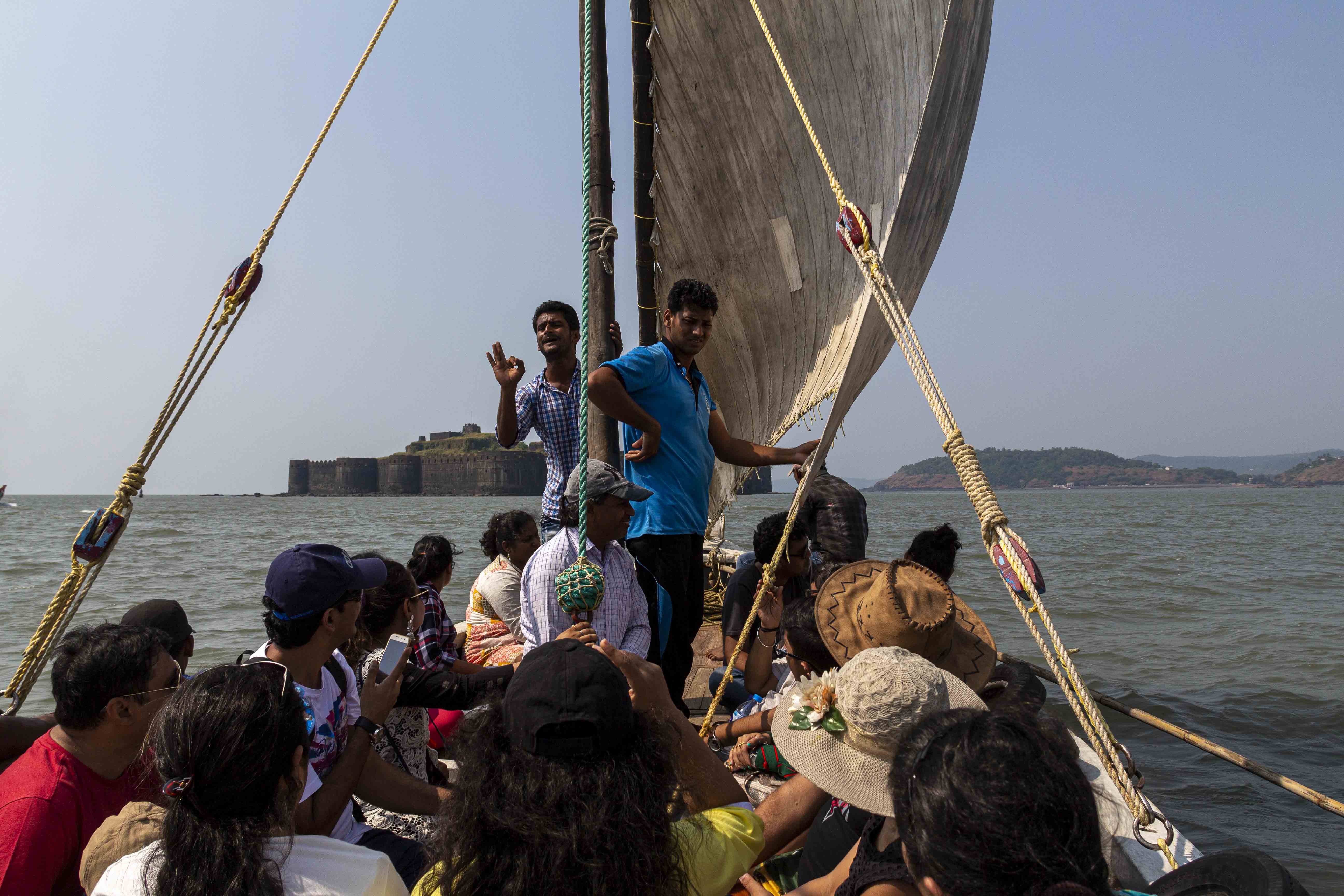
Travelling on a packed sailboat to Murud-Janjira fort (Photo: Paul Stafford for TravelMag)
As we neared the concealed entrance, a large curved gateway yawned open, between plump bastion cheeks. Steps led off at a tangent, protecting the interior from cannon shots. The lower steps were wet and slippery, but the crew were on hand to give a shove and catch that cleared us over the water. There was only enough space to load or unload one boat at a time. Others clustered around the entrance awaiting their turn.
Besides the difficulty of entering the fort, once inside, it quickly became even clearer why Murud-Janjira was never conquered. The walls concealed an interior of varying levels, with plenty of good vantage points from which to fire on invaders.
The alternative option open to would-be aggressors would have been to lay siege, often a plan destined for drawn-out success, given that the fort was isolated on a small island. However, there was a contingency for that also. Before long, we came to the first tank. Here, fresh water, possibly collected from rainfall, would have allowed the fort’s defenders access to potable water for many months, if not endlessly. Fish also swam in the tanks. Combined with the saltwater fish swarming the seas in abundance around the outside of the fort, for a race of fisherfolk, survival was all but guaranteed during a siege. There was never any need to leave the protective veil of the fort’s walls for food or water.
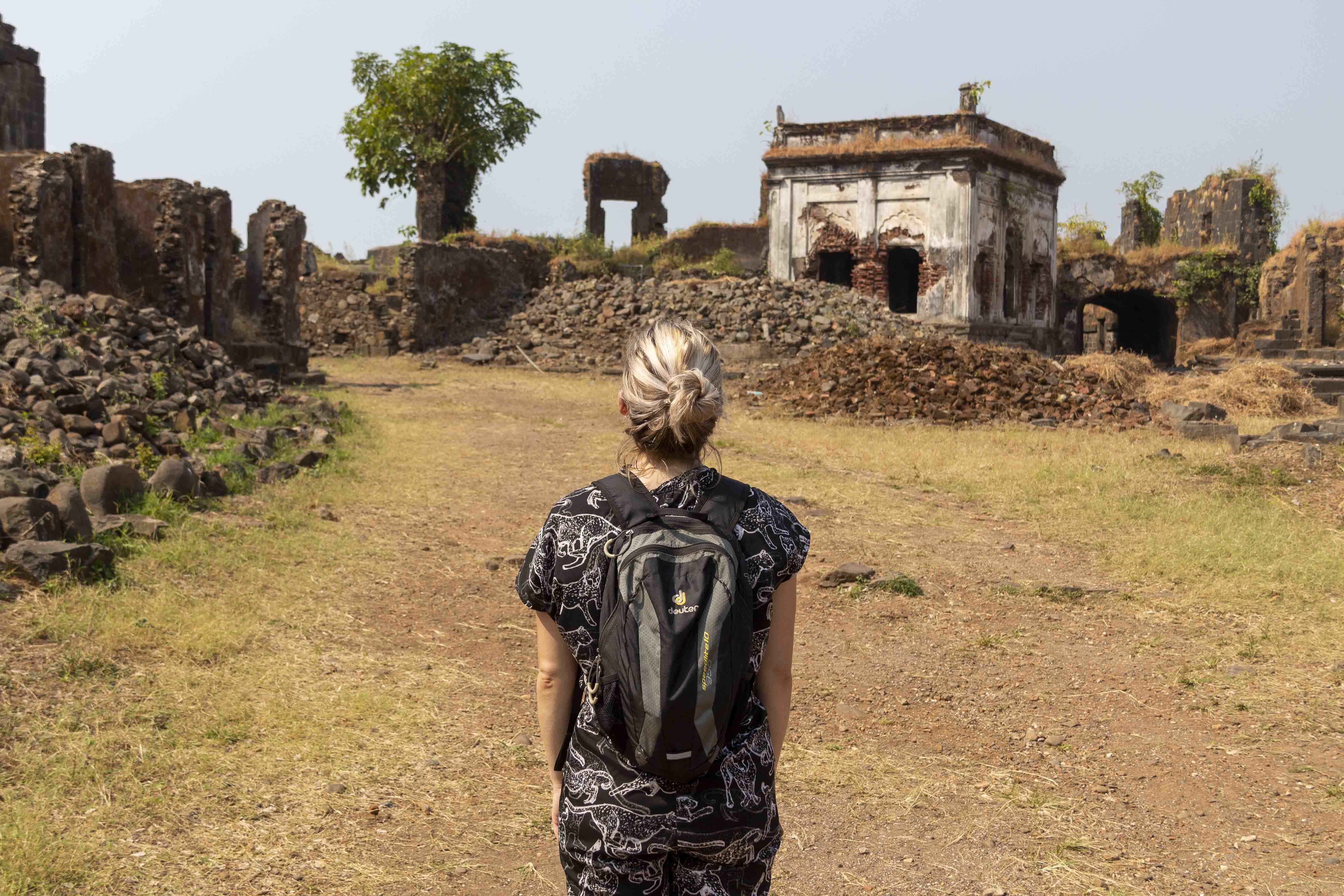
Inside Murud-Janjira fort (Photo: Paul Stafford for TravelMag)
Steps led to brick buildings, freshwater pools, former residences and military offices, so robust that I imagined they had changed little over time, despite decades of disuse. Elsewhere, there were piles of rubble scattered around the site, although it was never quite clear if they were piles of loose stone gathered together or were simply the product of mismanagement and decay. Everything was covered by the creep of fresh weeds and grasses that were in various phases of being burned off in the early phase of the dry season.
Life would have been uncomfortable at times. Even now, the journey, the heat and the humidity made simple actions like walking arduous. Sweat rolled down my temples to a steady drip-drip that began to soak into my shirt. We trudged up the steps to the lookout. A dutiful sentry would have been able to raise the alarm for all who approached from the sea and would have had an even more advanced warning of enemy troops amassing on the land.
The Siddis were attacked variously by the Portuguese and British, but their biggest challenge came from the Marathas, whose empire once controlled a vast chunk of the Indian subcontinent from the Arabian Sea to the Bay of Bengal. When their attacks failed, which included attempts to tunnel to the island and to scale the walls, the Marathas built their own fort on a smaller island nearby.
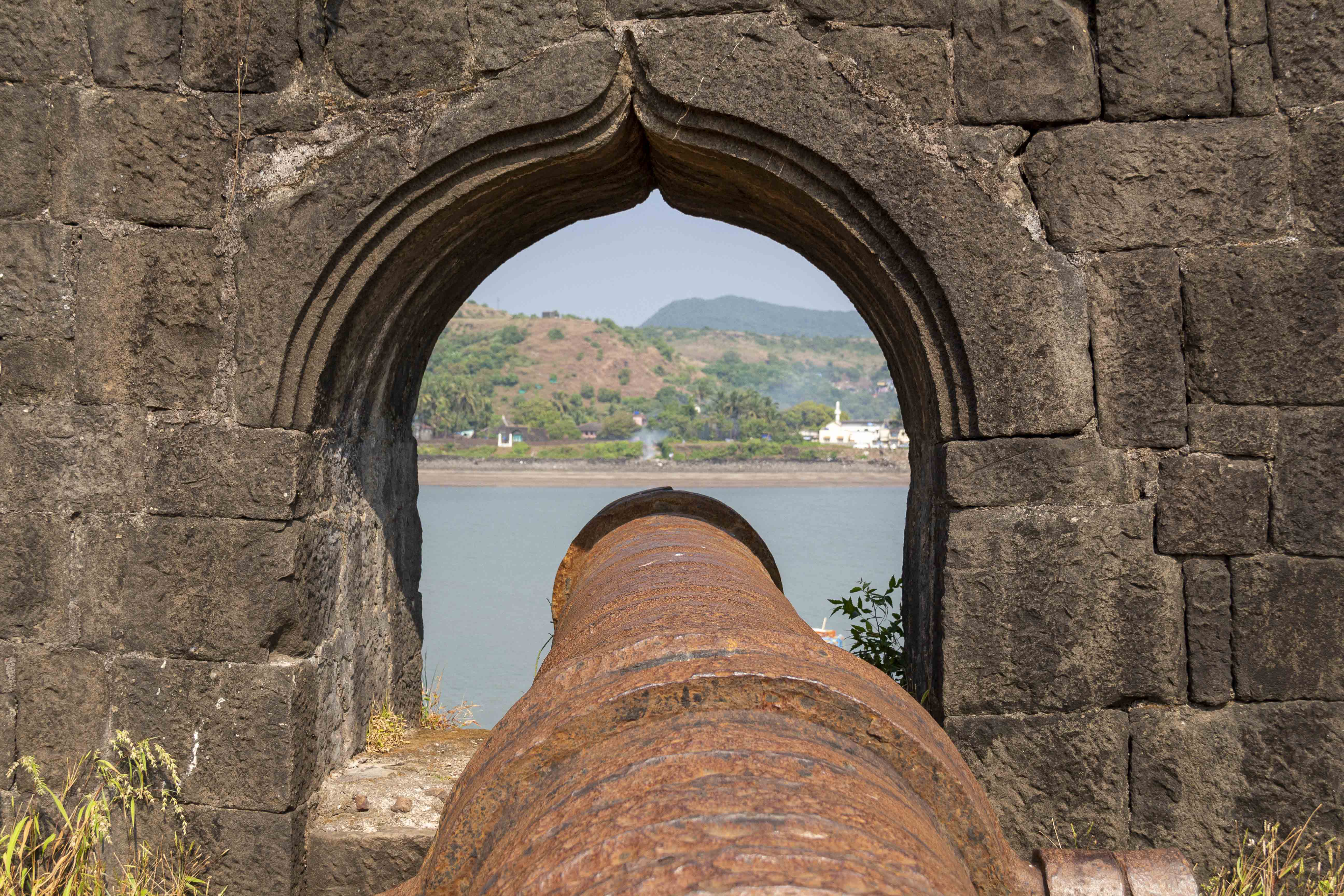
Rusting cannon at Murud-Janjira fort (Photo: Paul Stafford for TravelMag)
From the top of the Murud-Janjira island fort, we looked out towards Padmadurg island fort. Although smaller in size than Murud-Janjira, the Marathas were much stronger as an empire and merely needed a fort of their own for control of the Arabian Sea, leaving the Siddis largely in peace once Padmadurg was completed in 1676.
As I imagined what the scene must have been like in those days, I realised that the little sailboats with their dirtied sails were offering a rather realistic glimpse. No imagination necessary. Even the smattering of buildings along the shore gave the aspect of simple fishing villages untouched by electricity or other modern inventions in the midday light.
As I melted into this illusion, one of our fellow boat party asked for his photo to be taken with Helena using his mobile phone. Snapped out of my reverie, I realised at once that I’d fallen into the trap of overly romanticising the past, while rejecting many of the positives of the present, such as the fact that outsiders, of different nations, can peacefully congregate inside a fort that was once zealously guarded. Which was just as well, because the only way back to the mainland for us all, was in the overcrowded old sailboat, which would be almost as difficult to get into as this fort was in 1630.
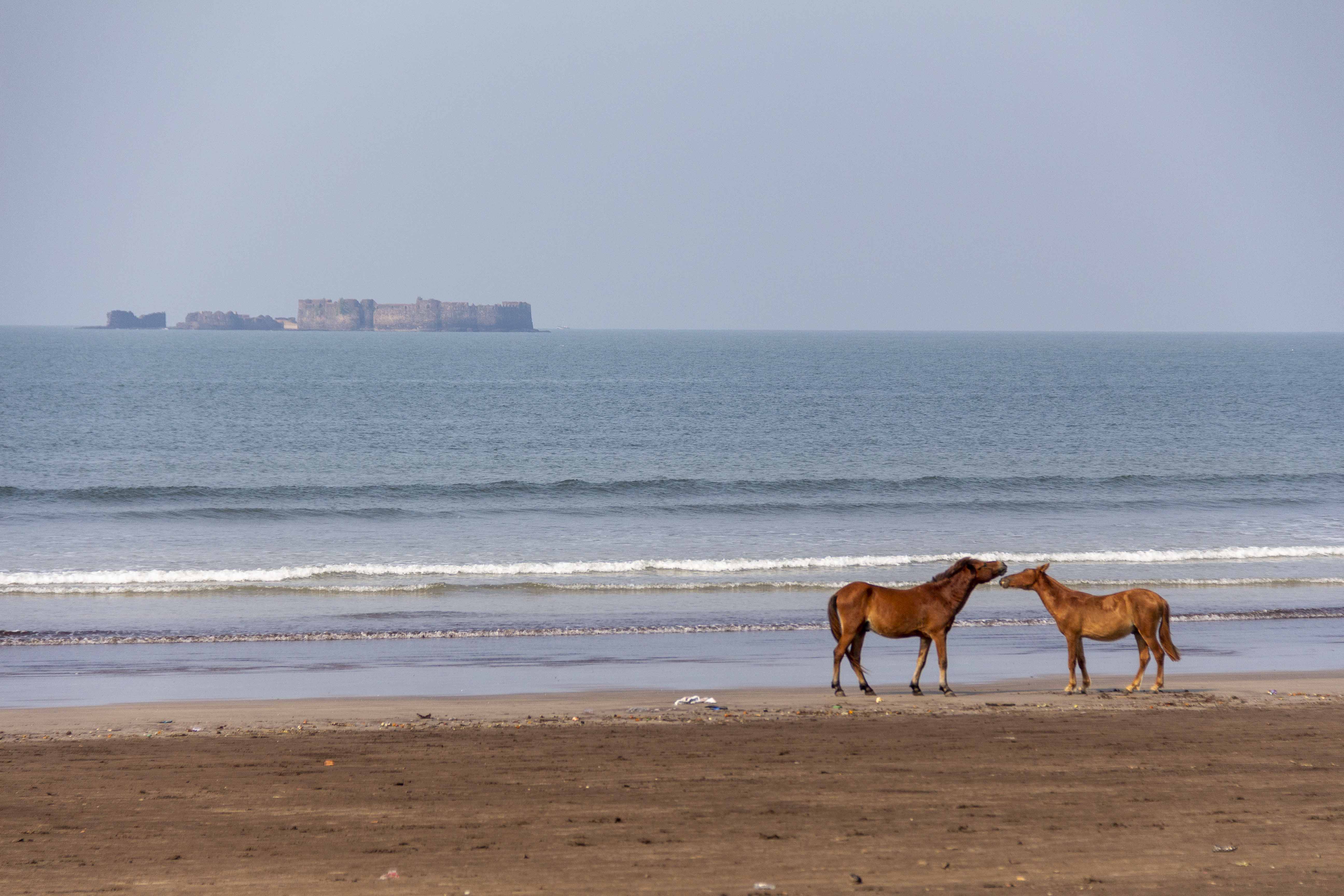
Horses play on Murud beach with Padmadurg fort in the distance (Photo: Paul Stafford for TravelMag)
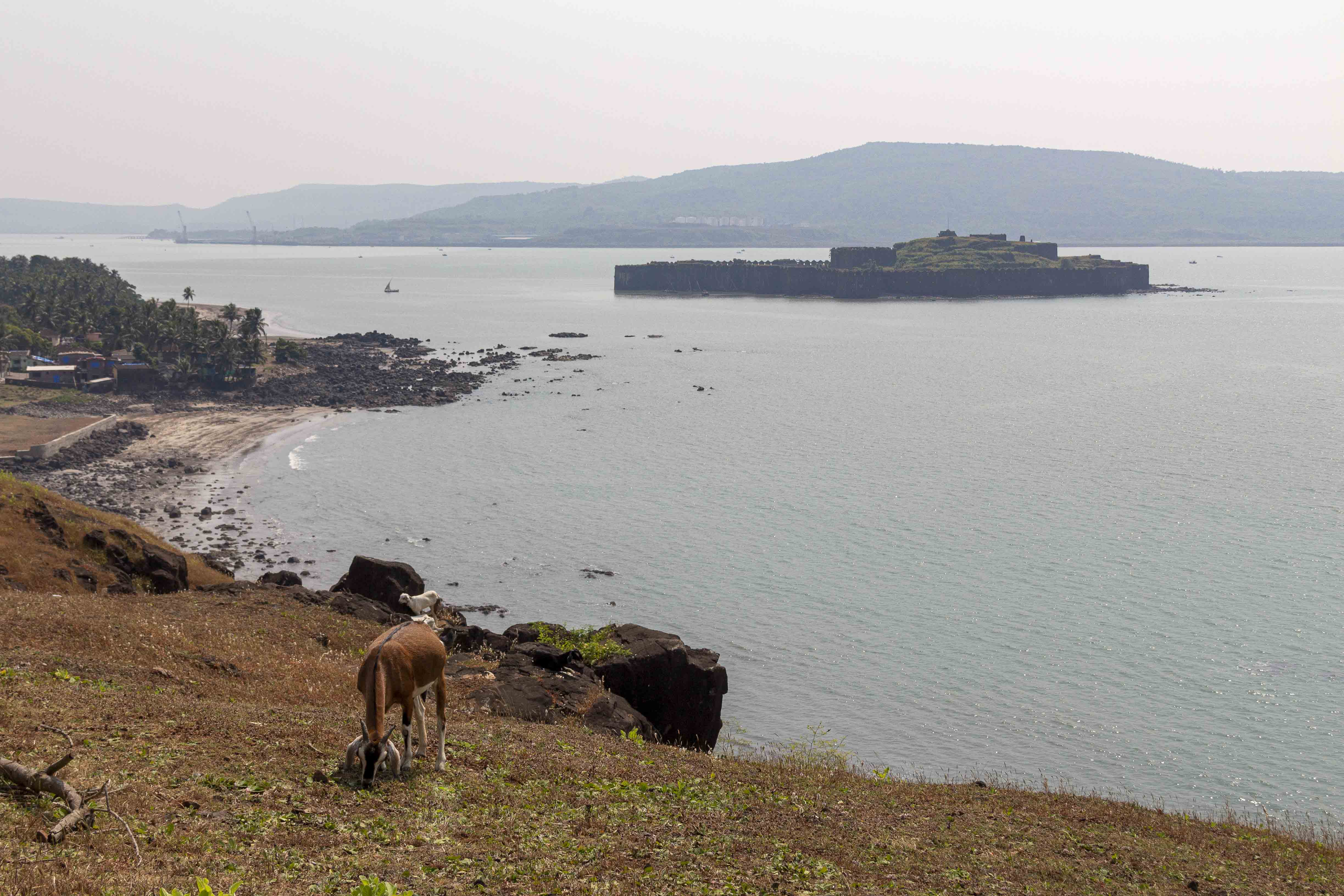
A goat grazes in front of Murud-Janjira fort (Photo: Paul Stafford for TravelMag)